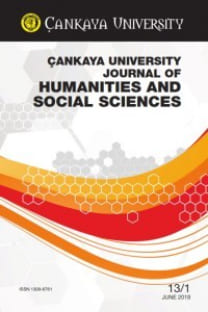Reading Through Pictures: The Lion, the Witch and the Wardrobe
Resimler anlatının görsel unsurları olarak fantastik kurgunun en sık karşılaşılan özelliklerinden biri olmuştur. Bu türün sunduğu sınırları olmayan hayali alanlar çeşitli biçim ve şekillerle, karmaşık veya ba- sit olarak görsel öğelere dönüştürülmektedir. Bu tarz çizim ve resimlerin varlığı fantastik kurgunun çocuk edebiyatı içinde yer aldığı tezini güçlendirse de anlatı ve resimler arasındaki bariz ve karmaşık ilişki ince- lenmeyi hak eder. Resim kullanımı bir gelenek haline geldikçe metinlerarası ilişkiye benzer bir resimlera- rası ilişki kurulabilir. Metinler arasındaki resimsel izler fantastik kurguda anlatının doğası hakkında yeni anlayışların ortaya çıkmasına yardımcı olabilir. İngiliz edebiyatının en önemli fantastik romanlarından bi- ri olan ve C. S. Lewis tarafında yazılan Aslan, Cadı ve Dolap bu girişim için güzel bir örnek oluşturabilir. Bu çalışmada, Aslan, Cadı ve Dolap ile Caroll’un Alice Harikalar Diyarında, Le Guin’in Yerdeniz Büyü- cü adlı eserleri ve Tolkien’in Yüzüklerin Efendisi üçlemesi arasında resimlerarası ilişki kurulup bu ilişki- nin anlam ve anlatı üzerine katkıları tartışılacaktır
Reading Thorough Pictures: The Lion, the Witch and the Wardrobe
T Pictures as the visual elements of the narrative have become one of the commonest features in fantastic fiction. Boundless imaginative landscapes offered by this genre are transferred into visual elements in varied forms and shape, complex or simple. Though the mere existence of such illustrations or pictures strengthen the idea that the fantastic is children’s literature, the obvious and intricate relationship between the pictures and the narration provides an interesting point that deserves analysis. As the use of illustrations has become traditionalized, inter-pictural relations can be established similar to intertextuality. Pictural traces among the texts may help to reveal fresh insights concerning the nature of the narration in the fantastic. C. S. Lewis’ The Lion, the Witch and the Wadrobe as one of the most important fantastic novels of English literature serves as a well example to such enterprise. In this study, the inter-pictural relations in The Lion, the Witch and the Wadrobe, with regard to Caroll’s Alice’s Adventures in Wonderland, Tolkien’s The Lord of the Rings trilogy, Le Guin’s The Wizard of Earthsea will be established and their contribution to the meaning and the narration will be discussed.
___
- Carroll, Lewis. (2009). Alice’s Adventures in Wonderland and Through the Looking-Glass (New York: Oxford University Press).
- Foucault, Michel. (1984). “What is An Author?”, in P. Rabinow (ed.), Foucault Reader..
- Genette, Gerard. (1997). Paratexts: Thresholds of Interpretation [translated by Jane Lewin] (New York: Cambridge).
- Le Guin, Ursula. (2010). A Wizard of Earthsea (London: Puffin Books).
- Lewis, C. S. (1994). The Lion, the Witch and the Wardrobe (HarperCollins: New York).
- Schakel, P. J. (2002). Imagination and the Arts in C. S. Lewis : Journeying to Narnia and Other Worlds (University of Missouri Press).
- Tolkien, J. R. R. (2008). The Fellowship of the Ring (London: HarperCollins).
